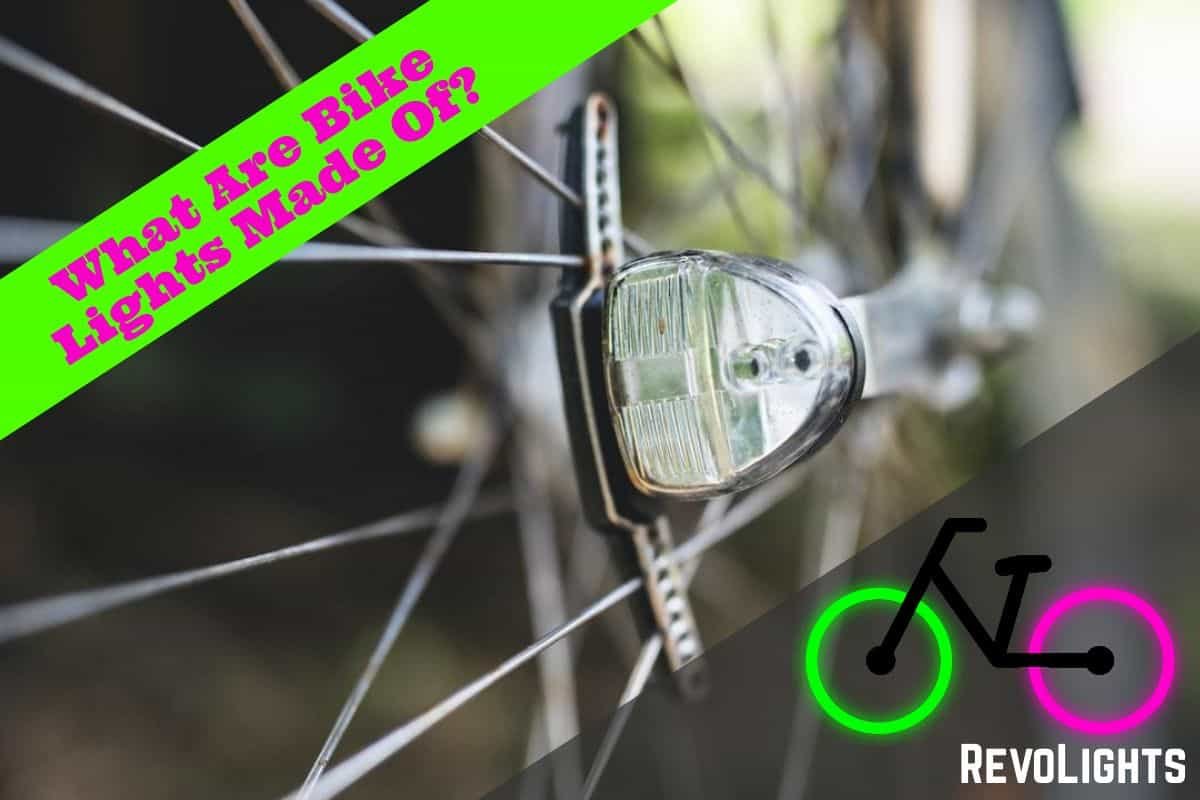Bike lights are a popular accessory for cyclists and individuals who love biking regularly. However, not everyone knows how they are made and the available types. So, what are bike lights made of? Many individuals ask the question because there are many market types.

In this article, I will discuss bike light materials and the most popular types used to build them. Read further to determine the best material, qualities, and benefits.
What Material is Used to Make Bike Lights?
Metal is the most common material used to make bike lights, which usually come equipped with an LED light for ultra-brightness and efficient luminance. While the material is sustainable, it also has long-lasting qualities that make it a better choice than plastic.
Aluminum
Aluminum is extremely lightweight and has a high strength-to-weight ratio. The material is highly resistant to rust, which is excellent when a bike light is exposed to rain. It’s also hygienic and easy to clean after constant use over a specific period.
There are three factors to consider if you’re interested in buying an aluminum bike light:
- Recyclable and Odorless
- Versatile and Flexible
- Reflective and Impermeable
As a durable and robust material, aluminum is 100% reusable. Therefore, if you should ever sell your bike light, most likely, it will maintain its good condition and be valuable to a buyer.
Titanium
Titanium is an exceptional mineral used to make bike lights. The material is much lighter than steel due to its low density, although it maintains a similar robust texture. It also has a high tolerance for intense heat while cycling on humid days due to its high melting point, massively increasing its strength.
Typically, titanium is a beneficial material for bike lights, providing a few qualities that make it sustainable:
- Decay Resistance
- Non-Toxic
- Low Thermal Expansion
- High Melting Tolerance
While Titanium is rare and beneficial, it can be more costly than other metals, increasing the price of bike lights. Ensuring you have enough money to cover your purchase is crucial when buying a high-grade product.
Steel
Steel is widely used and durable, although it isn’t pure metal. The material combines carbon and iron, which scientists use to increase its strength. It remains a top choice among bike manufacturers due to its impressive characteristics.
Check out a few benefits that highlight the extended life expectancy of steel and how it serves as a protective material:
- Sturdiness and Strength
- Lucidity and Quality
- Reliability and Security
As one of the most preferred metals in various industries, steel provides the durability needed for bike light preservation. It can last up to 20 years, which gives it an advantage over weaker materials that are imitations or completely impure.
Tungsten
Tungsten is pure and has the highest tensile strength compared to other metals. If that weren’t enough, it also has the highest melting point of any pure metal. The only other element that contains a higher melting point is carbon.
- High-Temperature Resistant
- Electronic Structure
- Low Thermal Expansion
One disadvantage of tungsten is its thickness, which is challenging but efficient for bike lights. The more sustainable the material, the better light can handle slight damage from poor weather conditions or improper handling.
There are a few other materials used to build bike lights. However, they don’t receive the same attention as various metal types:
Polyvinyl Chloride
« Best Bike Lights for Wheels
Why Are Bike Lights So Expensive? »
Polyvinyl chloride (PVC) is a polymer that consists of chloride and is produced by polymerization. The material is also highly sustainable and lightweight, making it an attractive material for bike construction. It also has several excellent qualities that are efficient for bikes.
- Cost-Effective
- Fire Resistant
- Durable
- Lightweight
- Flexible
PVC has flaws but remains an excellent material due to its uniqueness. It has a unique blend of qualities that make it particularly useful.
Rubber
Natural rubber is one of the most widely used materials with a high tolerance for harsh chemicals. It also has a long life expectancy compared to some metals. Other excellent qualities include cutting, tearing, wear, and fatigue and it adheres easily to different material types.
- Water Resistant
- Anti-bacterial
- Wear and Tear Resistant
- Biodegradable
- Low-Temperature Flexibility
When many individuals think of bike lights, they often immediately think of metals. You can still choose rubber if you opt for a particular material instead of the standard. Also, consider comparing rubber with durable metals to determine which suits your needs best.
What Qualities You Must Look for In a Bike Light
Some cyclists don’t consider particular characteristics when shopping for new bike lights. Qualities matter during the process because they can help you choose correctly. Here are three factors to remember if you’re considering a new bike light purchase.
Sustainability
Bike lights must handle an extensive degree of damage despite daily use. One common occurrence is bending, which can happen during bike accidents or improper installation. However, metal bike lights are resilient and repairable, depending on the severity of the damage.
High-Quality
Poorly made bike lights will likely last only a few uses after purchase. On average, a high-quality light should last up to two years, but it can function longer with proper maintenance and protection. They also provide the best lighting possible consistently and under various conditions.
Reliability
When biking in dimly lit areas, in poor weather, or at night, bike lights should provide exceptional lighting without affecting drivers and pedestrians and be long-lasting. Therefore, your bike light needs to function correctly and efficiently during every use. Some lights are defective or malfunction after only a short period. However, you can find a product worth your money and is consistently functional.
The common question, “What are bike lights made of?” is asked by professional bike riders and biking hobbyists curious about their structure and materials. Various other choices are available, but you must know the most reliable material types in depth. They can be challenging to distinguish initially, but as you research, you’ll be able to decide which qualities you prefer in your bike lights.




